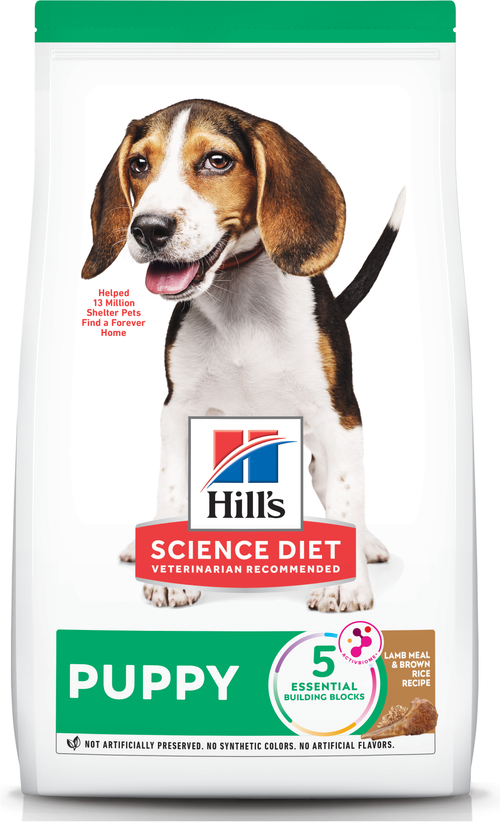
-
Find the right food for your petTake this quiz to see which food may be the best for your furry friend.Find the right food for your petTake this quiz to see which food may be the best for your furry friend.Featured products
 Puppy Large Breed Chicken & Brown Rice Recipe
Puppy Large Breed Chicken & Brown Rice RecipeVital nutrients to support 5 essential building blocks for lifelong health
Shop Now Puppy Lamb Meal & Brown Rice Recipe
Puppy Lamb Meal & Brown Rice RecipeVital nutrients to support 5 essential building blocks for lifelong health
Shop Now Hill's Science Diet Adult 7+ Senior Vitality Small & Mini Chicken & Rice Recipe Dog Food
Hill's Science Diet Adult 7+ Senior Vitality Small & Mini Chicken & Rice Recipe Dog FoodImproves everyday ability to get up & go
Shop NowFeatured products Adult Indoor Chicken Recipe Cat Food
Adult Indoor Chicken Recipe Cat FoodSupports energy level and beautiful fur in indoor cats
Shop Now Adult Sensitive Stomach & Skin Cat Food
Adult Sensitive Stomach & Skin Cat FoodHighly digestible food that is gentle on the stomach. Nourishes skin & promotes lustrous fur.
Shop Now Adult 7+ Chicken Recipe Cat Food
Adult 7+ Chicken Recipe Cat FoodSupports energy level and beautiful fur in mature cats
Shop Now -
Dog
- Dog Tips & Articles
-
Health Category
- Weight
- Food & Environmental Sensitivities
- Urinary
- Digestive
- Joint
- Kidney
-
Life Stage
- Puppy Nutrition
- Adult Nutrition
Cat- Cat Tips & Articles
-
Health Category
- Weight
- Skin & Food Sensitivities
- Urinary
- Digestive
- Kidney
-
Life Stage
- Adult Nutrition
Featured articles The Incredible Science Behind Your Pet's Microbiome
The Incredible Science Behind Your Pet's MicrobiomeLearn what a pet's microbiome is, how it contributes to your pet's gut & overall health, and why nutrition is important in maintaining healthy microbiomes.
Read More Water
WaterDiscover why water is the most important nutrient for your dog or cat to live a healthy life. Find out how much water your pet should consume each day.
Read More Pet Food Storage Tips
Pet Food Storage TipsDiscover how and where to store your dry, as well as canned, dog and cat food. Learn how to find the "best before" dates on all Hill's pet food packaging.
Read More -


If you've been eating dinner with hot breath and little paws on your lap every day, it is time to end the hungry pleading. A dog begging for food may be common, but it's neither cute nor healthy for him. Luckily, stopping your dog from begging at the table is a fairly simple task when all members of the family follow through.
Beggars Can Be Choosers
A dog who begs for food may just seem interested in imitating his human family (getting to eat at the table with everyone else is a bonus). But this behavior communicates more than just hunger. Dogs who beg for food are either not getting the nutrition they need from their own food, according to PetMD, or they're starved for something else: attention. How do you know which it is? Start with the food you are feeding your dog — is it filled with quality ingredients or mostly byproducts? Make sure he's getting pet food that meets his nutritional needs, and spread out the feeding times to create two to three smaller meals per day. This simple change could stop the begging almost immediately. Ask your vet for dog food recommendations or check out these Hill's® Science Diet® products that are balanced with the nutritional value that your dog needs to be healthy.
Sleep It Off
If your dog continues to beg after his nutritional needs have been met, the next thing to do is to evaluate the amount of attention he is getting. If possible, consider having play time before your own meal times. This will allow you to burn a few extra calories before you dine, and possibly encourage your pooch to take a little nap while you eat. However, some dogs will try to beg and be at your side all day despite satisfaction otherwise. For those guys, you'll need to use some deeper training techniques.
Time and Consistency
Ignoring your dog's persistent effort to sneak food from your plate will not solve the problem. And although it is important to tell him "no" to instill good habits, you should accompany it with a command you want him to replace the begging with. After telling your dog "no," for example, you might then say "bed" or "lay down." Both commands will direct your dog to leave the area. Now the tricky part of this training is to not reward him for obeying the command itself. If you do, you'll have taught your dog to beg and then lie down for food. Instead, work on these two alternate commands at other times of the day and reinforce that good behavior.
Positive Reinforcement
When initially teaching these good habits, you should say "good dog," pet your dog, then offer a training treat. As he progresses you can remove the treat and then just reinforce with verbal commands. Once your dog has mastered laying down somewhere specific, you can use that command against dog begging at meal time. If after a few weeks you aren't seeing any progress, you may need to use a gate to nudge him in the right direction while you're eating. Keep in mind this should be your last resort; you should still continue to wean him off begging when food is on the table.


Tasty Tips
Be Consistent
Training is only effective if you are consistent. If you don't want your dog to beg for human food, then you need to avoid giving him any, not just occasionally. This also needs to be a household rule, as all members of the family should subscribe to this behavior. This can be difficult with small children, as they themselves, are learning good behaviors too. They might struggle to understand why they can't reward their furry best friend with a bite off of their plate. It can be as important to teach your children not to feed the dog human food as it is to train your dog to not beg for it. Finally, if you let your dog around company, make sure they understand not to feed the dog too. This can be even more important if you have a family member or friend dog-sit for you, as they might not have the same feeding rules in their own home.
Dogs are Best Friends, Not Vacuums
The last thing to remember when teaching your dog to not beg, is to avoid any instances where he might be tempted. Dogs are naturally curious creatures so good smelling food within reach of their ever-sniffing nose is a temptation. Avoid leaving food out on counters or coffee tables that your dog can access. Also, make sure that your dog can't get into your trashcan or tip it over to rummage through the garbage inside. It is also helpful to note that while it might seem like dogs are nature's best vacuum cleaners, you should not allow your dog to eat food that has accidentally dropped on the floor.
Finally, if you have small children, make sure to keep an eye out for disappearing vegetables off of their plate. Letting your children sneak food to the dog under the table can encourage begging behaviors. While kids need their vegetables to grow up big and strong, some foods like broccoli can cause digestion issues for dogs, so it is best for your pup to stick to a nutrition made specific to his needs. Contrary to humans, dogs can be perfectly happy eating the same dog food all their lives, by not allowing them access to human food, even as a taste, will help curb their begging tendencies.
Dog begging ultimately ends where rewarding begins. All the good things you want your dog to do should come with the same incentives you'd teach kids as they grow up. Be sure to reinforce all good behaviors with treats, attention, words, and happy expressions. Your four-legged companion is the epiphany of unconditional love. They truly want to please you, and when you reciprocate the right way, the unfavorable behaviors like begging at the dinner table do go away.


Chrissie Klinger is an educator, writer and mother of two children, three dogs and three cats. Her dog Jake loves sitting on her lap every chance he gets! She enjoys living an active and eco-friendly lifestyle in rural Pennsylvania.
Related products

Improves everyday ability to get up & go

Improves Everyday Ability to Get Up & Go

Vital nutrients to support 5 essential building blocks for lifelong health

Vital nutrients to support 5 essential building blocks for lifelong health
Related articles

Understand the role that Omega-6 and Omega-3 fatty acids play in your dog's overall health, and how you can ensure they are getting enough.

Discover fun and engaging games and other ways to help your dog exercise, keeping him happy and healthy.

Learn basic steps & precautions for treating a cut on your dog, including what you can put on the cut, and when you should take them to the vet.

Large and giant breed puppies have different nutritional needs than other dogs. Learn how to provide the special care they need to grow up big and strong.

Put your dog on a diet without them knowing
Our low calorie formula helps you control your dog's weight. It's packed with high-quality protein for building lean muscles, and made with purposeful ingredients for a flavorful, nutritious meal. Clinically proven antioxidants, Vitamin C+E, help promote a healthy immune system.
Put your dog on a diet without them knowing
Our low calorie formula helps you control your dog's weight. It's packed with high-quality protein for building lean muscles, and made with purposeful ingredients for a flavorful, nutritious meal. Clinically proven antioxidants, Vitamin C+E, help promote a healthy immune system.

